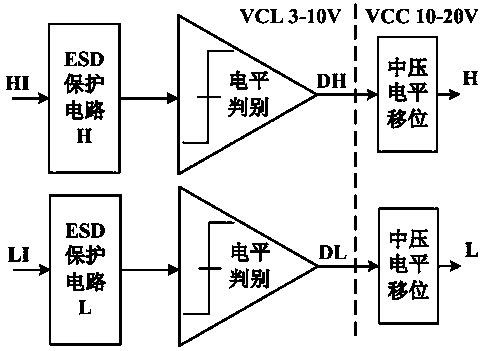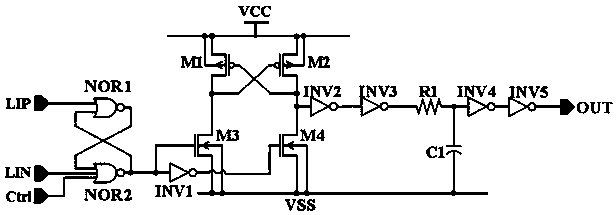High-speed high-efficiency high-voltage half-bridge gate drive circuit
A gate drive circuit and output drive circuit technology, which is applied in the field of high-speed, high-efficiency, high-voltage half-bridge gate drive circuits, can solve the problems of reducing the switching frequency of the system, increasing the damage of the switch, and increasing the driving delay.
- Summary
- Abstract
- Description
- Claims
- Application Information
AI Technical Summary
Problems solved by technology
Method used
Image
Examples
Embodiment Construction
[0049] The present invention will be described in further detail below in conjunction with the accompanying drawings and examples.
[0050] figure 1 It is a structural block diagram of a high-speed, high-efficiency, high-voltage half-bridge gate drive circuit of the present invention. The high-speed and high-efficiency high-voltage half-bridge gate drive circuit includes an input receiving circuit, a dead-time generating circuit, a low-voltage generating circuit, a low-side delay circuit, a low-side high-efficiency output drive circuit L, and a low-delay high-voltage level shift circuit And high-side high-efficiency output drive circuit H.
[0051] Among them, the low-voltage digital input signals HI and HI first enter the input receiving circuit, and perform signal level discrimination and logic level high-voltage conversion to obtain medium-voltage signals H and L; the dead-time generation circuit obtains high-side differential input according to the medium-voltage signal H...
PUM
 Login to View More
Login to View More Abstract
Description
Claims
Application Information
 Login to View More
Login to View More - R&D
- Intellectual Property
- Life Sciences
- Materials
- Tech Scout
- Unparalleled Data Quality
- Higher Quality Content
- 60% Fewer Hallucinations
Browse by: Latest US Patents, China's latest patents, Technical Efficacy Thesaurus, Application Domain, Technology Topic, Popular Technical Reports.
© 2025 PatSnap. All rights reserved.Legal|Privacy policy|Modern Slavery Act Transparency Statement|Sitemap|About US| Contact US: help@patsnap.com



